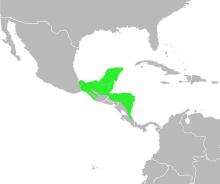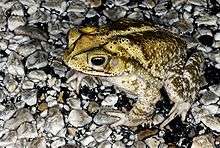Gulf Coast toad
The Gulf Coast toad (Incilius valliceps) is a species of toad native to eastern and southeastern Mexico and Central America as far south as Costa Rica.[3][4]
| Gulf Coast toad | |
|---|---|
.jpg) | |
| Scientific classification | |
| Kingdom: | Animalia |
| Phylum: | Chordata |
| Class: | Amphibia |
| Order: | Anura |
| Family: | Bufonidae |
| Genus: | Incilius |
| Species: | I. valliceps |
| Binomial name | |
| Incilius valliceps (Wiegmann, 1833) | |
 | |
| Synonyms | |
|
Bufo trachypus Wiegmann, 1833 | |
Description

The Gulf Coast toad is a medium-sized toad species, ranging from 5.1 to 10.2 cm (2 to 4 in) in length.[5] Their back varies in color from nearly black, to shades of brown and grey with a distinctive white or yellowish colored stripe down the center, and sometimes lighter colored patches on the sides. Their underside is yellow or cream colored. Their back is covered in small tubercles, while their underside is normally devoid of them.
I. valliceps has the most extensive ridging of any toad in its geographic range. The ridges extend from the nose, to the back of the head, and with a branch that wraps around the back side of the eye.
Habitat
The Gulf Coast toad is found in a wide range of habitats, including open grassland, semi-arid regions, light forest, and even suburban backyards. They are typically found not far from a permanent water source, which they use for breeding in the spring, but they are capable of travelling long distances while foraging for food.
Diet
Like most toads, the Gulf Coast toad is an opportunistic carnivore. It will eat almost any small arthropod it is able to overpower and swallow.
References
| Wikimedia Commons has media related to Incilius valliceps. |
| Wikispecies has information related to Incilius valliceps |
- Santos-Barrera, G.; Wilson, L. D.; Savage, J.; Bolaños, F.; Acevedo, M. (2010). "Incilius valliceps". IUCN Red List of Threatened Species. 2010: e.T54789A11191593. doi:10.2305/IUCN.UK.2010-2.RLTS.T54789A11191593.en.
- "Bufo valliceps". Integrated Taxonomic Information System. Retrieved 22 October 2009.
- Conant, Roger; Joseph T. Collins (1998). A Field Guide to Reptiles & Amphibians: Eastern and Central North America (3rd ed.). Houghton Mifflin Harcourt. pp. 521–522. ISBN 978-0-395-90452-7.
- Frost, Darrel R. (2015). "Incilius valliceps (Wiegmann, 1833)". Amphibian Species of the World: an Online Reference. Version 6.0. American Museum of Natural History. Retrieved 9 December 2015.
- "Bufo valliceps Gulf Coast Toad". Herps of Texas. University of Texas at Austin. Retrieved 2015-08-21.
